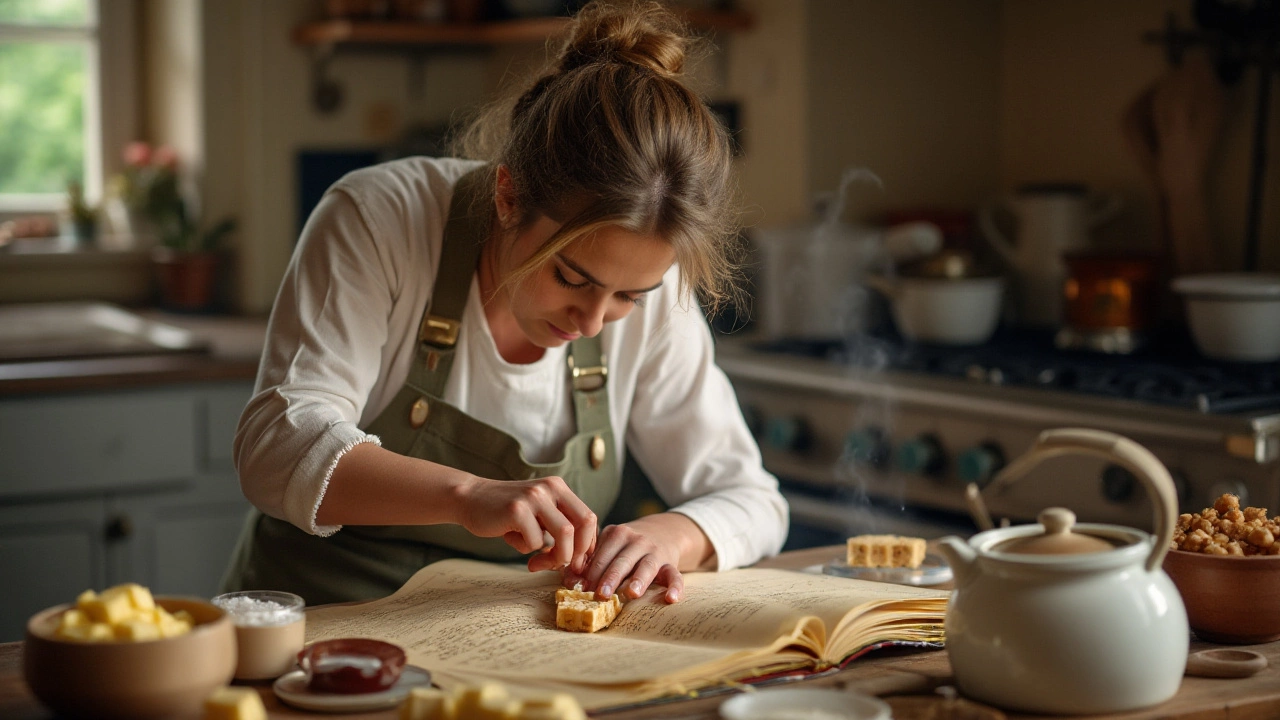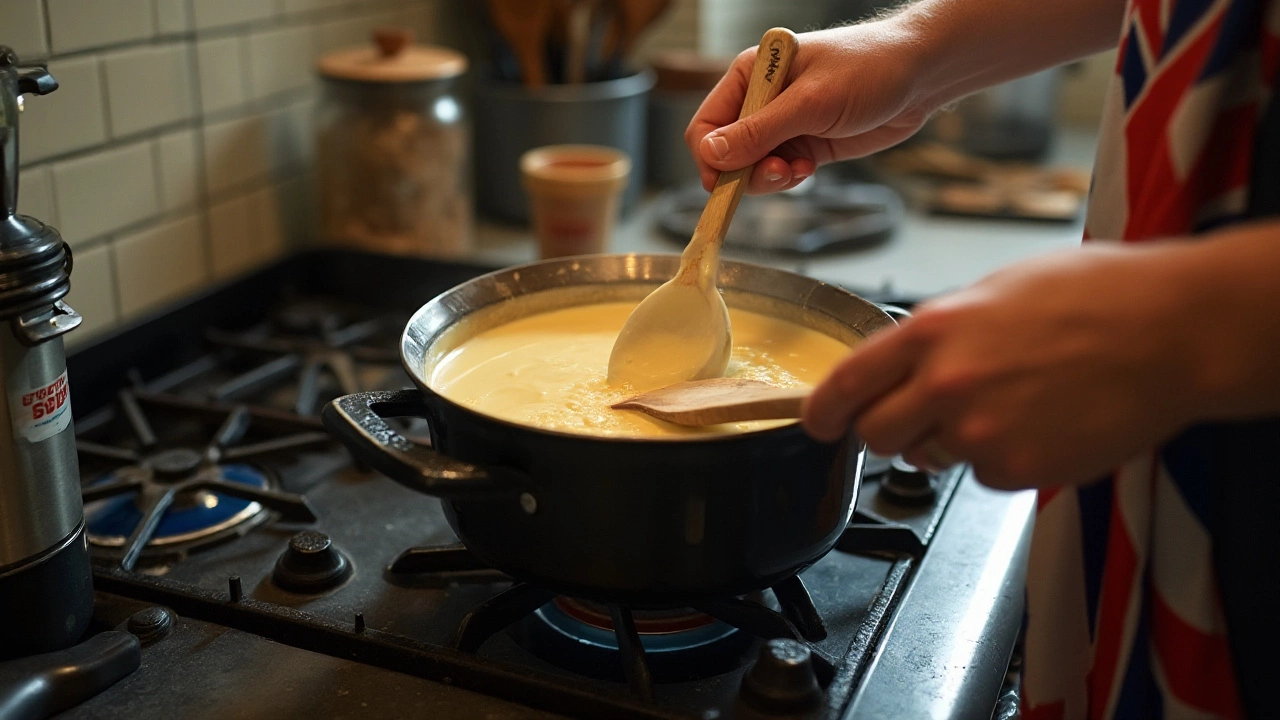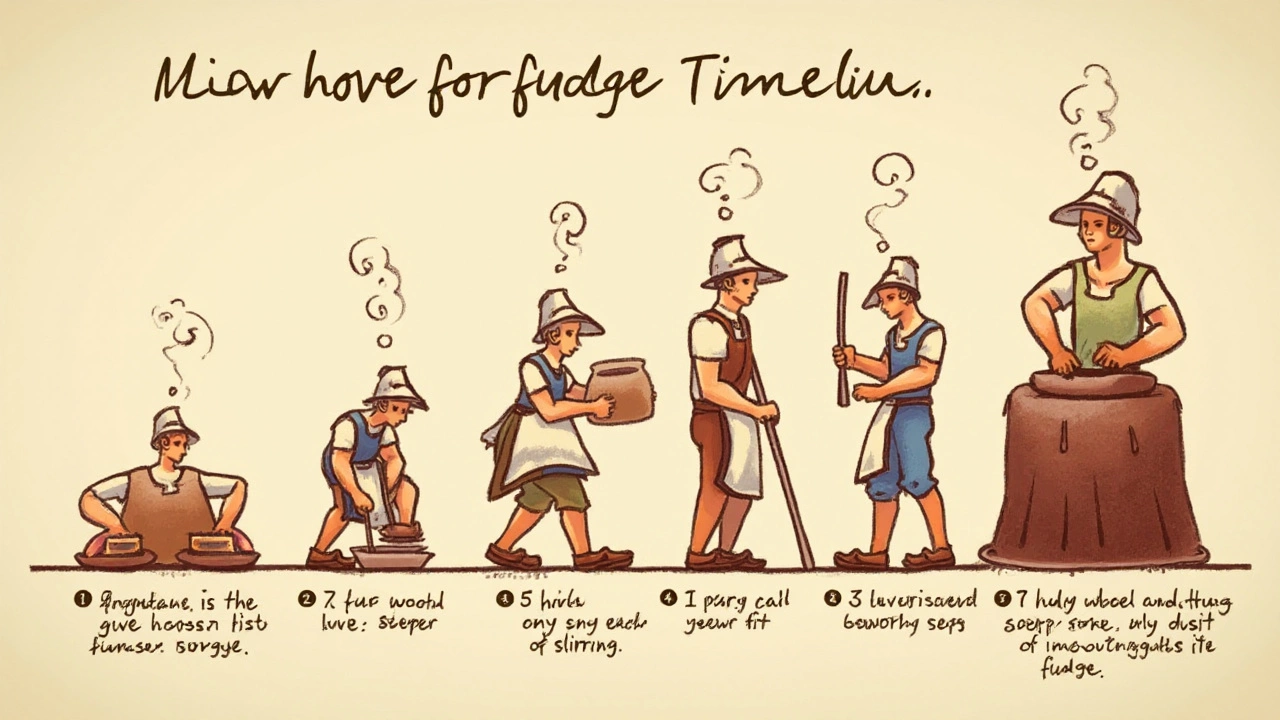
Ah, the sweet allure of fudge! A classic treat that holds a special place in many people's hearts. Crafting fudge isn't just about combining ingredients; it's a fine balance of technique and timing—and nowhere is this more evident than in the question of whether you should stir the mixture while it boils.
Everyone seems to have an opinion—from seasoned chefs to enthusiastic home bakers—about when or if stirring is necessary. In this article, we'll journey through the chemistry and artistry behind making this creamy confection. Whether you're seeking the smoothness of a traditional chocolate fudge or the sweet complexity of nutty variations, understanding the nuances of stirring is key.
Join me as we unravel the mystery, provide some foolproof stirring methods, and share a sprinkle of tips to ensure your fudge turns out perfectly every time. Whether you're a newbie looking for guidance or an old hand seeking to refine your technique, you'll find valuable insights here.
- The Science Behind Fudge-Making
- When to Stir and When to Stand Back
- Common Mistakes and How to Avoid Them
- Expert Tips for Perfect Texture
- Exploring Fudge Variations and Flavors
The Science Behind Fudge-Making
Crafting the perfect fudge is as much a science as it is an art form. At its core, fudge is a type of confectionery dependent on sugar, butter, and milk. The magic lies in the transformation of these simple ingredients through a precise cooking process. This process is deeply rooted in the science of sugar crystallization. When sugar is heated with a liquid, like milk, and reaches the 'soft ball stage'—about 235 to 245 degrees Fahrenheit—an intriguing transformation occurs. It's the temperature required to create that delightful soft yet firm texture that distinguishes fudge from other sweets.
During this stage, stirring becomes a point of debate. If you stir too much, you run the risk of encouraging undesired crystal formation, which can result in a grainy texture. However, not stirring at all can lead to uneven mixing, possibly resulting in burnt sugar at the bottom of your pot. This intricate balance can oftentimes be the difference between success and failure in your fudge-making adventure. An interesting observation by food scientist Harold McGee notes that "the process of making fudge is akin to balancing on a knife-edge, where slight deviations can tip you into failure." This highlights the precision that fudge-making demands.
To understand why stirring is such a vital part of boiling fudge, let's delve a bit into the role of sugar. Sugar crystals naturally desire to form, and when one begins, others quickly follow, creating a chain reaction. It's this widespread crystal formation that creates that grainy feel—a textural disappointment many fudge-makers dread. Throughout history, basking in the sweet success of smooth fudge was a sign of one's culinary prowess.
Modern culinary experts sometimes recommend allowing the mixture to cool slightly before starting vigorous stirring. This technique aims to reduce premature crystallization. By offering a slight delay, the sugar crystals have less opportunity to form too soon. Of course, this requires patience—a sometimes elusive trait in eager cooks.
You may be curious about ways to consistently achieve the perfect balance. Achieving the right temperature alone can be a trial; factors like humidity and altitude can affect boiling points, making a kitchen thermometer an indispensable tool. Keeping the heat even and steady is particularly helpful, often enhanced by the use of a heavy-bottomed pan. Investing in quality equipment is not simply indulgence—it's a necessity for consistent results.
As we unravel the intricacies of fudge-making, the importance of science cannot be overstated. Beyond the measurements and heat control, each decision along the way hinges on scientific principles. Whether you're aiming for smooth chocolate or a vibrant mint variety, understanding these underlying concepts enhances not only your results but your confidence in the kitchen. Keeping these elements in mind, you'll be better equipped to tackle even the trickiest of fudge recipes with success.
When to Stir and When to Stand Back
Making the perfect batch of fudge can sometimes feel like trying to solve a delicious mystery. Among the many questions that fudge enthusiasts ponder, stirring during the boiling process stands out. At its core, the decision to stir or not boils down to understanding the chemistry involved. While it may be tempting to constantly stir, doing so can lead to grainy textures, a bane for fudge aficionados. During boiling, sugar dissolves completely, but consistent stirring can inadvertently encourage early crystallization, which is often undesirable for the creamy result most desire.
Typically, when you first combine your fudge mixture ingredients—often sugar, butter, and milk—it’s essential to stir until everything is well mixed. This initial stirring ensures that all ingredients are uniformly combined, which is crucial for an even cook. However, once that mixture begins to bubble, many recipes suggest letting it be. Why? Stirring during this phase can agitate the sugar molecules, leading them to crystalize too soon. The result? A fudge that’s gritty rather than smooth.
Famous chocolatier and confectioner, Dorcas Reilly, once advised, "Let your sugar rest when the bubbles dance. Patience is sweeter than sugar in the art of fudge." These words highlight the traditional wisdom of knowing when to let your mixture quietly simmer and when to intervene.
Yet, there are exceptions to every rule. If your recipe includes additional flavors or ingredients, like nuts or chips, it might ask you to briefly stir midway. These short bursts of stirring are typically safe and won’t drastically interfere with texture. If you must stir, consider using a wooden spoon, which is less likely to scratch your pot and disturb the mixture too aggressively.
For those who are more scientifically inclined, using a candy thermometer during the boil phase can also offer guidance. Fudge generally reaches a soft-ball stage at around 235 to 240 degrees Fahrenheit. By closely monitoring the temperature, you can ensure optimal conditions for sugar crystallization. Keeping the thermometer handy helps you decide if any intervention is necessary without physically disrupting the process.
Many seasoned confectioners swear by time-tested techniques. Emphasizing the art of 'standing back' during crucial moments acknowledges the integral role of natural forces in fudge-making. So before you reach for your spoon, consider the chemistry dance in your pot—it might just be the difference between a good batch and the perfect one.

Common Mistakes and How to Avoid Them
Making fudge can seem deceptively simple—just melt, mix, and set. But anyone who has endeavored to create this luscious treat knows it holds a few hidden challenges. One of the most common errors is not paying attention to temperature and timing. Fudge demands precision, especially when it comes to heating the sugar mixture. If you rush this step, you risk a grainy texture that can disappoint even the most accommodating sweet tooth. Investing in a reliable candy thermometer ensures accuracy, helping you avoid these gritty mishaps.
Another frequent pitfall is incessant stirring during the boiling phase. Many home cooks instinctively want to keep stirring, fearing the mixture might stick or burn. However, constant agitation can cause premature crystallization of sugar, leading to a coarse, unpleasant finished product. Once the mixture comes to a boil, give it a gentle stir to ensure even heat distribution, then let it bubble away undisturbed until it reaches the desired temperature. As renowned chef Julia Child once said,
“A good cook is like a sorceress who dispenses happiness,”and mastering patience in this stage will indeed make you feel like a culinary magician.
Another error to note is incorrect cooling practices. Immediately transferring your molten concoction from the pan to a cold marble slab might seem like a good idea, but it can cause shock cooling, affecting the texture. Instead, let the fudge sit at room temperature until it naturally begins to thicken, only then should you proceed to beat it. This gradual transition nurtures a creamy consistency that melts in your mouth.
And don't forget the importance of using the right amount of butter and cream. Skimping on these rich ingredients for a slightly healthier option may seem tempting, but it often results in a fudge that is too firm or dry. The creamy indulgence of fudge comes from a balanced ratio of sugar to fat, and altering this can tip the delicate scale, producing inconsistent results. Embrace the decadence and use full-fat cream and butter for a luscious, irresistible texture that defines great fudge.
Finally, a common mistake is not experimenting with different flavor combinations. While chocolate fudge remains a beloved classic, there's a whole world of possibilities awaiting exploration. Incorporate textures like chopped nuts or a swirl of caramel to create interest. As you perfect your technique with these tips, remember to personalize your recipes to suit your taste, making each batch uniquely yours. Whether it's the richness of cocoa or the sweetness of maple syrup, let your creativity guide you in creating a fudge masterpiece.
Expert Tips for Perfect Texture
Creating remarkably smooth fudge is both an art and a science. It all begins with your understanding of the chemical reactions between sugar, milk, and butter. The temperature at which these ingredients mix and the conditions under which they cool significantly influence your final product. To achieve that creamy, melt-in-the-mouth texture cherished by fudge lovers, it’s vital to cook the mixture to the precise temperature. Invest in a reliable candy thermometer, as it’s the only way to check that your confection has reached the ‘soft ball stage,’ typically around 235 to 240 degrees Fahrenheit (112 to 116 degrees Celsius). On this heat, sugar dissolves into a solution, forming a network that entrains air, providing that desirable smooth texture once cooled. This approach ensures a seamless integration of ingredients, establishing both consistency and flavorful nuance intrinsic to classic fudge recipes.
Timing is another key component in preparing exquisite fudge. Once you've reached the optimal cooking temperature, it's wise to let your mixture cool undisturbed. The waiting period, often stretching to an hour or more, allows sugar crystals to reform slowly, crucial for a silky result. As tempting as it might be to rush the process or expedite cooling with refrigeration, patience often reaps rewards in the culinary arts. Allowing it to settle at room temperature encourages microscopic crystals to form gradually, a crucial step for achieving that soft, non-grainy structure in your finished product. For that perfectly textured fudge, stick to using essential tools like wooden spoons, known for their non-reactive properties, helping navigate your mixture without affecting flavor or condition.
Many experienced fudge makers advise against stirring the mixture while it’s boiling. Early stirring can lead to seed crystal formation, resulting in undesirable graininess. Instead, reserve the stirring for later. Once cooled, vigorous but careful mixing introduces those smooth, creamy textures that are the hallmark of good fudge. As Mary Berry, a renowned British baking expert, once opined,
"The secret to fudge is not just in the ingredients but in leveraging time and temperature judiciously. Allowing sugar crystals to grow too quickly is a common pitfall."When stirred to perfection upon cooling, the sugar crystals align themselves harmoniously, delivering that sought-after creaminess.
Offering flexibility while emphasizing the fundamentals is crucial. Remember, every kitchen operates differently—humidity, elevation, and even cooktop style can impact results. Adjustments are often necessary, so don’t shy from tweaking the core recipe to suit your environment. Most importantly, keep experimenting, as each batch increases your intuitive understanding of this process. As your familiarity grows, so too will your ability to play with flavors and textures, ensuring your signature fudge becomes a much-anticipated treat at gatherings. With practice, experimentation, and the guidance found here, your fudge will soon boast taste and texture that competes with any confectioner’s offering.
Finally, don't be afraid to flavor finesse your fudge batches with add-ins post-mix, once the cooling begins but before complete setting. Think nuts, as they not only inject extra flavour but also offer intriguing contract textures. For variety, dried fruits or splash of liqueur can elevate your fudge from mere confection to cherished delicacy, inviting even more praise than the last time you shared this delightful creation. Like any culinary adventure, achieving the perfect fudge texture is a journey worth taking, sprinkled with the sweet satisfaction of mastery.

Exploring Fudge Variations and Flavors
Fudge is more than just a simple confectionery; it's a canvas for creativity, offering endless possibilities to explore different flavors, ingredients, and textures. Traditionally, fudge recipes call for sugar, butter, and milk, but stepping outside the conventional path can lead to delightful new experiences. Take, for example, the rich and decadent chocolate fudge. To make it unique, consider adding a swirl of mint or a hint of orange zest, which can transform the mouthfeel and taste, making every bite an explosion of flavors. The versatility of fudge allows you to experiment with layers of marshmallow cream or introduce the robust, earthy tones of cinnamon and nutmeg for a warm, wintery treat.
For those with an adventurous palate, why not try infusing your fudge with international inspirations? Think matcha green tea fudge, which not only brings a vibrant color but also an exotic, slightly bitter undertone beautifully balanced by the sweet, creamy base. For a more savory twist, incorporating bacon or sea salt into your fudge can bring an unexpected but delightful contrast, making each piece a palatable adventure. These varieties scream sophistication and can be the ideal treat for an afternoon tea or a special holiday gathering, where guests will marvel at your inventive spin on the classic sweets.
The journey into fudge variations doesn't stop there. Consider the nutty richness of pecan or walnut fudge, which adds a delightful crunch and earthy flavor. Nuts can be roasted, candied, or even coated with spices like cayenne for those who enjoy a bit of heat with their sweet. Adding dried fruits like cranberries or apricots introduces a chewy texture and a burst of tanginess, offering a beautifully balanced flavor profile. As Maria D. Ripova, renowned pastry chef, once said,
"The heart of fudge-making lies in daring to innovate, in seeking that intriguing juxtaposition of flavors that surprise yet comfort."
Another exciting realm of fudge flavoring stems from experimenting with various alcohols. A dash of bourbon or rum can add warmth and depth to the dessert, elevating the overall experience. Remember to maintain a balance—often, a spoonful is all that’s needed to infuse the fudge without overpowering the other ingredients. For summer festivities, you might consider creating a tropical twist with hints of pineapple and coconut rum, giving you a taste of a beach holiday packed into every bite. These creative combinations highlight the limitless potential of this beloved treat.
Engaging in fudge-making is like embarking on a sweet, sensory adventure. Whether you're a seasoned confectioner or just starting out, the key is to embrace the creativity that stirring fudge inspires. The endless variations not only bring joy to those who make them but also to those lucky enough to taste these delectable creations. As experimentation fuels innovation, let your imagination take the lead in your next batch of fudge, and watch as traditional boundaries melt away, leaving behind a deliciously sweet masterpiece.